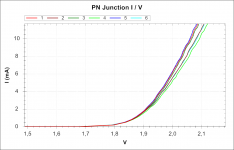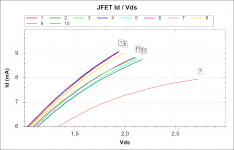Hi Preamp,
How do you feed all those little mouths? You have a small army lined up in formation - and yes, many antennas!
Take a look: Ulti-Preamp preamp.org
That's the preamp I'm going to feed with the Dual Salas, by the way. 😎
And what's the matter with many antennas? I didn't quite get that

My first thought was to use copper foil, but the #24 bus wire was adequate. I think I used #30 wire-wrap wire for the drains and sources. But the main point was to use it in a simple amplifier stage to see if it exhibited VHF oscillations, which it did not. I couldn't really measure the noise without a lot more work, but based on the reduction expected from paralleling it should have been below 300pV/sq rt Hz. Of course it is easy to spoil that unless the surrounding circuitry is up to the task.Hi Preamp,
How do you feed all those little mouths? You have a small army lined up in formation - and yes, many antennas!
Hi Brad,
I wouldn't have known that, thanks.
Did you just stick the assembly onto a board using one set of pads? You could use some kynar wire as guys!
Did you use round or flat wire? I'm just curious because you used the gate lead wire as a heat radiator (I think that's what you were getting at).
-Chris
JFET chips are usually with drain and source connections with lead wires on the top, with the backside making the gate connection. The venerable 2N4416 chip is small enough to sit on the squared-off top of the isolated Kovar gate lead of the TO-72 case. TI made theirs that way, whereas other manufacturers squashed the gate lead into the borosilicate sealing glass, making for significantly worse lossy-dielectric noise when used in cooled charge preamps. Borosilicate glass is not a very good dielectric.
I think the reference was to the hairpinned 100 ohm resistors used in the emitters of all the output stage bipolars, as they resembled antennae.And what's the matter with many antennas? I didn't quite get that
Here's a pic of the regulators with stacked 431s.A pic I posted on FB for a friend, of another regulator, with the stacked TL431, I referred to as line dancing.
Attachments
Take a look: Ulti-Preamp preamp.org
That's the preamp I'm going to feed with the Dual Salas, by the way. 😎
And what's the matter with many antennas? I didn't quite get that
Hi Preamp,
You said this revised design will be symmetrical +/-15V. Does that also mean it will be tracking (ie : +ve and -ve rails will be identical and will follow each other)?
Best regards,
Paul
Hi Brad,
Okay, I was expecting a larger gate conductor. I think it's cool that the JFET chip would sit happily on top of a lead. Of course, most of us wouldn't have a clue that the Borosilicate glass was anything but glass-like in it's characteristics. I would have expected higher temperatures to bring out worse behavior, not cooler! Now, how would you get the construction details for the 2N4416 device without buying an assortment and dissecting them?
Hi Paul,
-Chris
Okay, I was expecting a larger gate conductor. I think it's cool that the JFET chip would sit happily on top of a lead. Of course, most of us wouldn't have a clue that the Borosilicate glass was anything but glass-like in it's characteristics. I would have expected higher temperatures to bring out worse behavior, not cooler! Now, how would you get the construction details for the 2N4416 device without buying an assortment and dissecting them?
That's how I took it. I guess these young folks have never seen an entire street sprouting antennas (circa very late 60s when more people had a set).the reference was to the hairpinned 100 ohm resistors
Hi Paul,
Not quite. One polarity is the master that has it's own error amp and voltage reference. The other supply senses the opposite polarity as a zero voltage (normally one diode drop in reality) and corrects for any change in that voltage. So when the master drops (call it the negative as I normally see them), the reference point goes more positive. The positive regulator has to drop it's voltage to restore the old resting value. (one diode drop positive) If you look at a bunch of 1980s and 1990's schematics for receivers, you will be able to find some examples of this to study.Does that also mean it will be tracking (ie : +ve and -ve rails will be identical and will follow each other)?
-Chris
Hi Brad,
What was your final target voltage? I can see they are spread out, so they can dissipate more.
-Chris
What was your final target voltage? I can see they are spread out, so they can dissipate more.
-Chris
They were ten for each 25V reference, as part of a +/- 60V regulator. I think the rms noise in each |60V| was about 3uV in a 22kHz BW, better than required for the application. I also tapped off of the strings for lower voltage references for +/- 18V regs, which are for some d.c. servos.Hi Brad,
What was your final target voltage? I can see they are spread out, so they can dissipate more.
-Chris
About the JFETs: I sawed the tops off the cases of various 4416 parts, in part to experiment with optoelectronic resetting of the pure-integrator preamps. After a while I realized there was no real need for it, and I used small geometry RF NPN bipolars, selected MRF502, which even at room temp and 5V Vce had a Icbx of <100fA, and cooled much less.
At roughly dry ice, but tightly stabilized, temperatures, it was fun to watch the sawtooth waveforms at the preamp output at quiescence, ramping up by a volt or so per second --- considering that the feedback cap was ~130fF, consisting of a bit of bus wire in proximity to the JFET gate lead, separated with teflon tubing, and with the whole works in a vacuum.
Hi Brad,
Hat's off to a true hacker - in a good way! You must have killed a bunch of parts looking for the level where you could uncover the die. Sounds a bit like good fun in a severely twisted sort of way.
-Chris
Hat's off to a true hacker - in a good way! You must have killed a bunch of parts looking for the level where you could uncover the die. Sounds a bit like good fun in a severely twisted sort of way.

-Chris
No; remember, metal cans. The die and connecting bond wires were well below the top of the can. Just dry gas until one went way too low.Hi Brad,
Hat's off to a true hacker - in a good way! You must have killed a bunch of parts looking for the level where you could uncover the die. Sounds a bit like good fun in a severely twisted sort of way.
-Chris
I did try to grind down an SM dual transistor recently, with less --- definitive --- results.
Hi Brad,
-Chris
No, I didn't look it up. The hermetic can makes these things way easier to snoop on. I guess the lead type should have told me what kind of case it was.No; remember, metal cans
But ... it was still fun - right? They really ought to make a TO-78 in a surface mount version, what do you think?I did try to grind down an SM dual transistor recently, with less --- definitive --- results.
-Chris
That's how I took it. I guess these young folks have never seen an entire street sprouting antennas (circa very late 60s when more people had a set).
That's true; partly due to me being born in the '80s and to not having that much streets/houses on the small islands where I live and was born...
My first thought was more along the lines of emitter resistors acting like antennas for a detrimental effect 😱...
Not quite. One polarity is the master that has it's own error amp and voltage reference. The other supply senses the opposite polarity as a zero voltage (normally one diode drop in reality) and corrects for any change in that voltage. So when the master drops (call it the negative as I normally see them), the reference point goes more positive. The positive regulator has to drop it's voltage to restore the old resting value. (one diode drop positive) If you look at a bunch of 1980s and 1990's schematics for receivers, you will be able to find some examples of this to study.
Your description sounds a little, well, complicated 😉. I'd say no, the voltages don't track each other, as each rail has it's own Zener reference for voltage. The only thing different is the 'tap-off' point for the Zener's current sources, so that they have more voltage range to work with than 1 Vbe. This will only have negligible effect on the output voltage in terms of tracking.
Thanks anatech and preamp. I was thinking of r2r ladder dac applications where +/- need to be identical and stay that way...
Have a look at this (scroll down to the last schematic): Simple Dual-voltage Tracking Power Supply for 3 to 15 volts joebrown.org.uk
Something similar should work with a Salas, too.
Something similar should work with a Salas, too.
That's how I took it. I guess these young folks have never seen an entire street sprouting antennas (circa very late 60s when more people had a set).
-Chris
Unfortunately I'm not young.
Yes, with an increase in noise. Salas quite correctly identifies the merits of his approach, which includes low noise gain.Have a look at this (scroll down to the last schematic): Simple Dual-voltage Tracking Power Supply for 3 to 15 volts joebrown.org.uk
Something similar should work with a Salas, too.
Of course the noise may still be quite low in tracking supplies.
No, certainly not. The combination of a constant-current source and a shunt regulator is among the best for fast load response and outstanding line regulation.Noise may be higher, but low noise is not the only benefit of a shuntreg, is it?
One step beyond that is signal-based feedforward correction of either or both source and shunt. Oddly, I floated that idea in what is now called GroupDIY, and one guy couldn't see how it differed from a simple shunt reg.
And Ayre is claiming a two-quadrant regulator in a new product, as if this had not been done before. So it goes.
- Status
- Not open for further replies.
- Home
- Amplifiers
- Power Supplies
- The simplistic Salas low voltage shunt regulator


